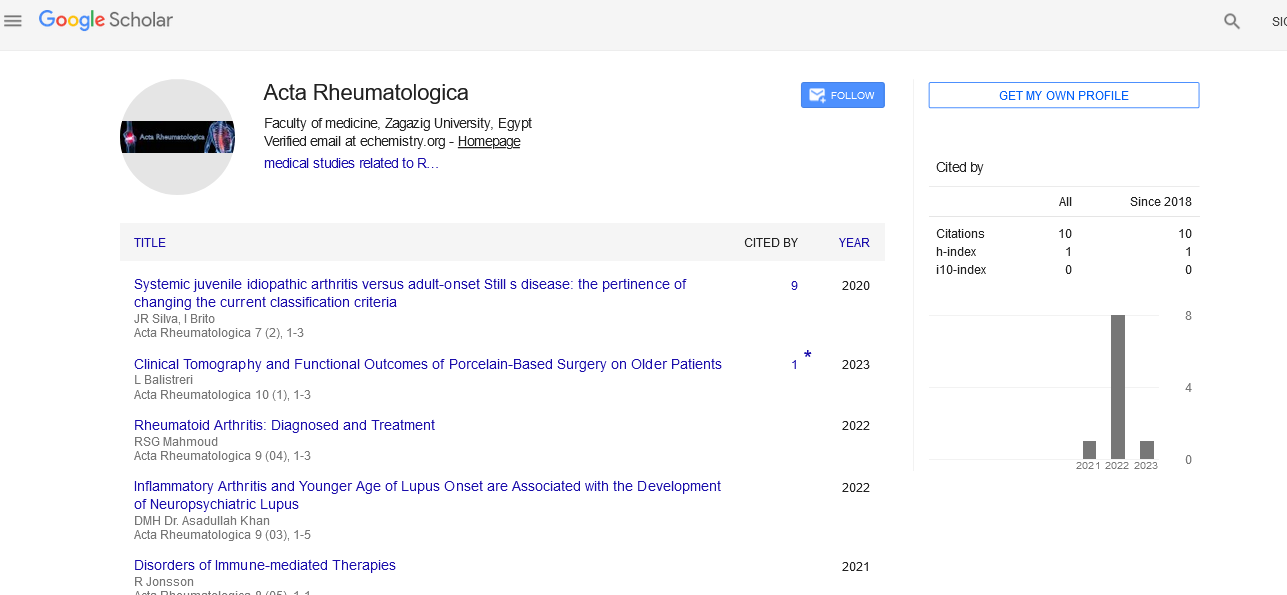Perspective - (2024) Volume 11, Issue 3
Musculoskeletal Disorders: Navigating the Intersection of Pain, Mobility, and Health
Viktor Persic*
Department of Health Care, University of Zagreb, Zagreb, Croatia
*Correspondence:
Viktor Persic, Department of Health Care, University of Zagreb, Zagreb,
Croatia,
Email:
Received: 16-May-2024, Manuscript No. IPAR-24-14801;
Editor assigned: 20-May-2024, Pre QC No. IPAR-24-14801 (PQ);
Reviewed: 04-Jun-2024, QC No. IPAR-24-14801;
Revised: 12-Jun-2024, Manuscript No. IPAR-24-14801 (R);
Published:
20-Jun-2024
Introduction
Musculoskeletal Disorders (MSDs) encompass a diverse array
of conditions affecting the bones, muscles, joints, ligaments,
tendons, and nerves, posing significant challenges to individuals,
healthcare systems, and societies worldwide. From the acute
trauma of fractures to the chronic pain of osteoarthritis, MSDs
manifest in various forms, impacting mobility, function, and
quality of life. In this article, we embark on a comprehensive
exploration of musculoskeletal disorders, elucidating their
etiology, clinical manifestations, diagnostic approaches,
treatment modalities, and avenues for ongoing research and
innovation.
The musculoskeletal system serves as the structural
framework of the body, enabling movement, support, and
protection of vital organs. Bones provide rigidity and shape,
while muscles generate force and motion through contraction
and relaxation. Joints facilitate articulation and range of motion,
while ligaments and tendons stabilize and connect bones and
muscles, respectively. Nerves innervate musculoskeletal
structures, conveying sensory information and coordinating
motor responses. Dysfunction or injury to any component of the
musculoskeletal system can precipitate the onset of MSDs,
heralding a cascade of structural and functional abnormalities.
Description
Osteoarthritis: The degenerative dilemma of aging
joints
Osteoarthritis (OA) stands as the most prevalent
musculoskeletal disorder, characterized by progressive
degeneration of articular cartilage, subchondral bone changes,
and synovial inflammation. Advanced age, obesity, joint trauma,
and genetic predisposition are among the myriad factors
implicated in OA pathogenesis. Clinically, OA manifests as joint
pain, stiffness, swelling, and diminished range of motion, leading
to substantial disability and impaired quality of life. While
conventional management strategies focus on pain relief,
physical therapy, and lifestyle modifications, emerging therapies
targeting cartilage regeneration and inflammation hold promise
for altering the disease course and preserving joint function.
Rheumatoid arthritis: Unveiling the autoimmune
assault on joints
Rheumatoid Arthritis (RA) represents a prototypical
autoimmune musculoskeletal disorder, characterized by chronic
synovial inflammation, joint destruction, and systemic
manifestations. Autoantibodies, including rheumatoid factor and
anti-citrullinated protein antibodies, play a central role in RA
pathogenesis, triggering aberrant immune responses against
self-antigens. The synovium, a dynamic tissue lining the joint
capsule, undergoes hyperplasia and infiltration by immune cells,
perpetuating local inflammation and cartilage erosion.
Treatment paradigms for RA have undergone a paradigm shift
with the advent of biologic agents targeting pro-inflammatory
cytokines and immune cells, offering unprecedented efficacy in
disease control and joint preservation.
Low back pain: The silent epidemic of modern life
Low Back Pain (LBP) stands as a ubiquitous musculoskeletal
disorder, affecting individuals of all ages and backgrounds, with
profound socioeconomic implications. While acute LBP often
resolves spontaneously, chronic LBP can be debilitating,
impairing mobility, function, and quality of life. Risk factors for
LBP include sedentary lifestyle, poor posture, occupational
hazards, and psychosocial stressors. Management of LBP
encompasses a multimodal approach, incorporating pain relief,
physical therapy, ergonomic modifications, and behavioral
interventions aimed at improving function and preventing
recurrence.
Fractures: Repairing the broken bonds of bone
Fractures represent acute musculoskeletal injuries resulting
from mechanical trauma, falls, sports-related accidents, or
pathological conditions. Depending on the severity and location
of the fracture, treatment modalities may range from
conservative measures, such as immobilization and physical
therapy, to surgical intervention, including open reduction and
internal fixation. Prompt and appropriate management of
fractures is essential in promoting optimal healing, restoring
function, and minimizing long-term complications, such as
malunion, nonunion, and post-traumatic arthritis.
Emerging therapeutic strategies and future directions
The landscape of musculoskeletal disorder therapeutics is
undergoing rapid evolution, fueled by advances in regenerative
medicine, biomechanics, and precision medicine. Regenerative
approaches, including stem cell therapy, tissue engineering, and
growth factor delivery, hold promise for enhancing tissue repair
and regeneration, particularly in conditions characterized by
cartilage and bone defects. Moreover, precision medicine
initiatives aim to tailor treatment strategies to individual patient
profiles, leveraging genetic, molecular, and imaging data to
optimize therapeutic outcomes and minimize adverse effects.
Conclusion
Musculoskeletal disorders represent a multifaceted challenge
with far-reaching implications for individuals, families, and
healthcare systems worldwide. By unraveling the complexities of
musculoskeletal pathology, embracing multidisciplinary
approaches to patient care, and fostering innovation and
collaboration, we can strive towards improved outcomes and
enhanced quality of life for individuals grappling with these
debilitating conditions. As we navigate the landscape of
musculoskeletal disorders, armed with knowledge, empathy, and
scientific ingenuity, we forge a path towards a future where
musculoskeletal health is preserved, and individuals thrive in
mobility and vitality.
Citation: Persic V (2024) Musculoskeletal Disorders: Navigating the Intersection of Pain, Mobility, and Health. Acta Rheuma Vol:11 No:3





